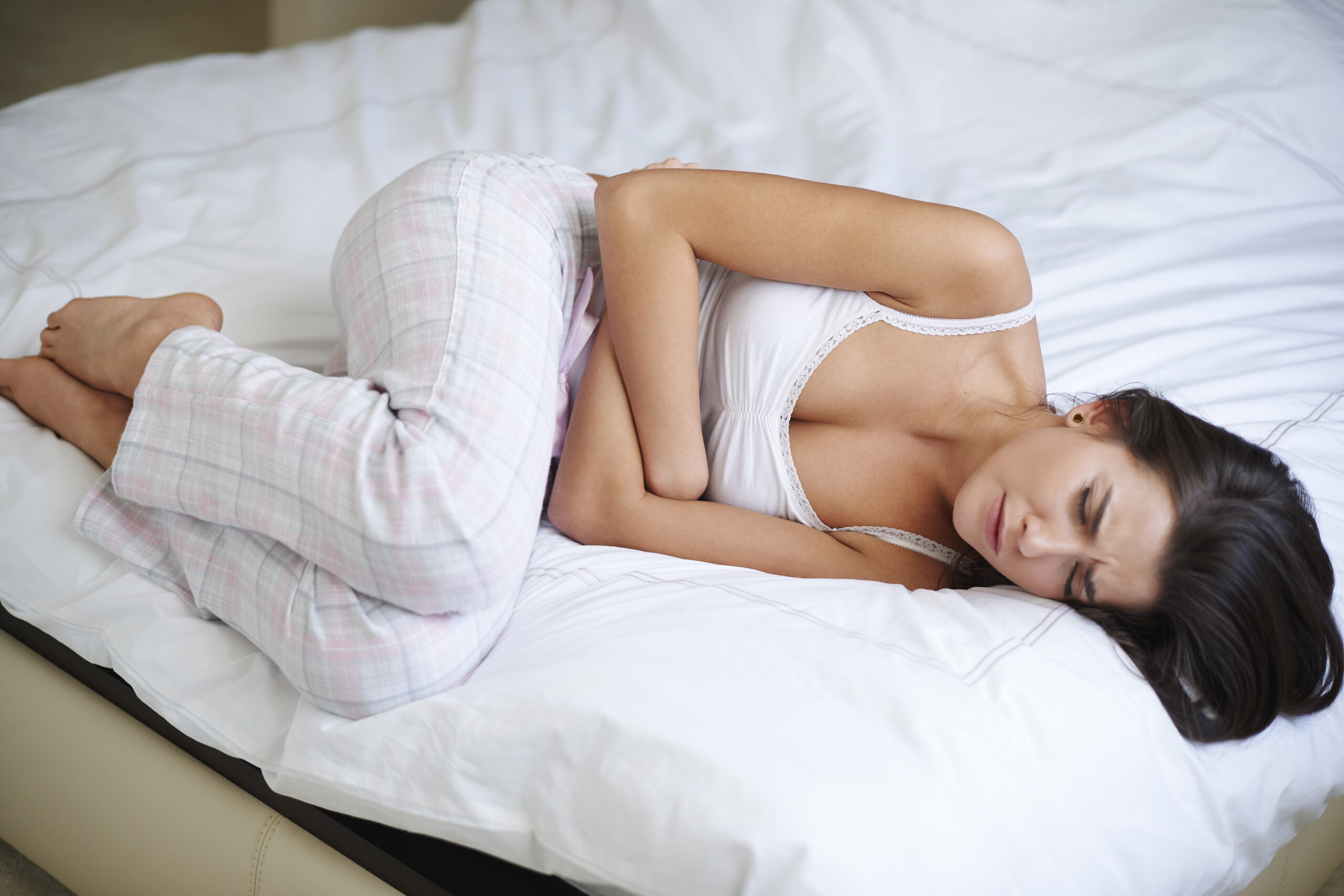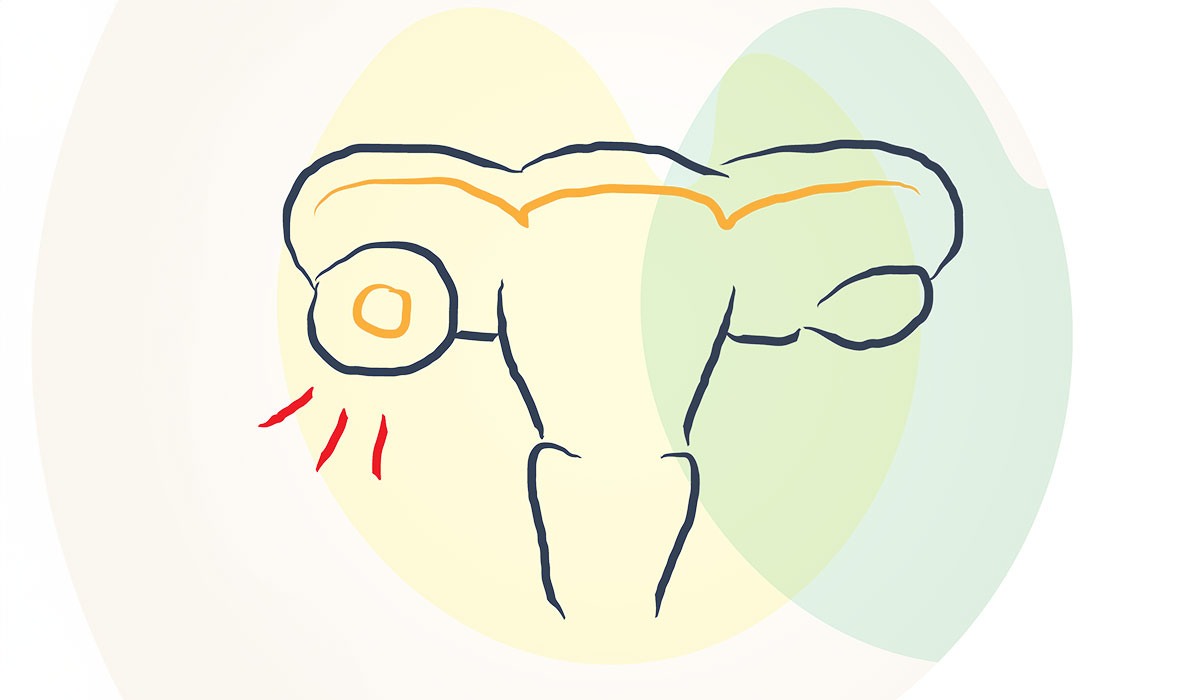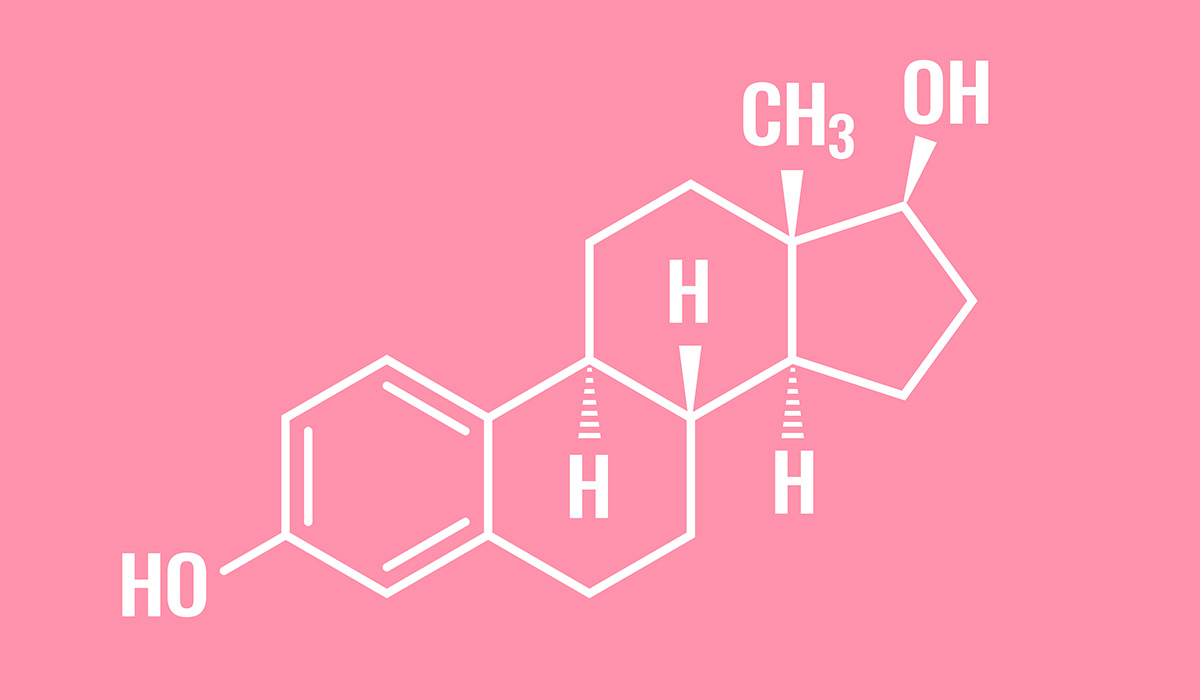Ovulation is the culminating moment of the menstrual cycle, during which the egg cell (oocyte) is released due to the interaction of complex neurohormonal mechanisms.
When the egg is mature, its covering in the form of a Graafian follicle ruptures, resulting in the release of the egg. It then moves from the ovary to the fallopian tube, ready for fertilization upon contact with sperm. The egg release stimulates the secretion of a hormone that inhibits the next ovulation cycle, which takes place at regular intervals.
Precisely determining the moment of ovulation is extremely important both for women who are planning to have children and for those who currently want to avoid getting pregnant. Determining the date of ovulation is directly related to calculating the fertile days.
It should be remembered that although ovulation lasts only one day and the egg can live from 6 to 24 hours, the periovulatory phase of fertility includes several days before ovulation and even four days after the egg is released.
When determining the ovulation date, a certain margin of error is assumed because ovulation may be postponed for various reasons, even during regular menstrual cycles.

Menstrual bleeding![]() occurs because the human embryo needs a thick and well-supplied uterine lining (this membrane is also called endometrium) to develop. In each cycle in which pregnancy does not occur, the endometrium is renewed, but the body cannot absorb all of it back into the bloodstream, and the remaining part is excreted through the vagina. The first day of bleeding is also the first day of the menstrual cycle.
occurs because the human embryo needs a thick and well-supplied uterine lining (this membrane is also called endometrium) to develop. In each cycle in which pregnancy does not occur, the endometrium is renewed, but the body cannot absorb all of it back into the bloodstream, and the remaining part is excreted through the vagina. The first day of bleeding is also the first day of the menstrual cycle.
There are many primordial follicles in the ovary from birth. From about day 6 of the menstrual cycle, one follicle becomes the dominant, i.e., the Graffian follicle![]() . Under the influence of FSH and estrogens, it undergoes further maturation. It secretes increasing amounts of estradiol and estrogen, which are responsible for producing characteristic mucus. With the onset of the follicular phase, the uterine mucosa has intensive proliferation, and the uterine glands are straight. The vaginal epithelium becomes keratinized, and its cells may be detectable in the smear.
. Under the influence of FSH and estrogens, it undergoes further maturation. It secretes increasing amounts of estradiol and estrogen, which are responsible for producing characteristic mucus. With the onset of the follicular phase, the uterine mucosa has intensive proliferation, and the uterine glands are straight. The vaginal epithelium becomes keratinized, and its cells may be detectable in the smear.
Ovulation![]() lasts about one day. In a 28-day cycle, ovulation will most likely occur on day 14 of the cycle. However, the egg cell can be fertilized for approximately 6-24 hours.
lasts about one day. In a 28-day cycle, ovulation will most likely occur on day 14 of the cycle. However, the egg cell can be fertilized for approximately 6-24 hours.
The luteal phase![]() is also the phase of the corpus luteum. The follicle from which the egg was released during ovulation turns into the corpus luteum. It produces progesterone, the concentration of which increases in this phase. Estrogen is low. The luteal phase duration is generally constant and lasts approximately 14-16 days from ovulation.
is also the phase of the corpus luteum. The follicle from which the egg was released during ovulation turns into the corpus luteum. It produces progesterone, the concentration of which increases in this phase. Estrogen is low. The luteal phase duration is generally constant and lasts approximately 14-16 days from ovulation.
The entire menstrual cycle lasts on average 28 days. However, this is an indicative book value. Most women have a slightly shorter or longer menstrual cycle. It usually ranges from 21-35 days. Cycles that do not exceed these values are said to be regular cycles.
Cycles that do not fall within the limits of 21-35 days are irregular cycles![]() . Irregular cycles are a regular occurrence in girls who start menstruating. They usually normalize by the age of 19. If this does not happen, it is worth seeing a gynecologist to determine the cause of this abnormality.
. Irregular cycles are a regular occurrence in girls who start menstruating. They usually normalize by the age of 19. If this does not happen, it is worth seeing a gynecologist to determine the cause of this abnormality.
As a woman approaches ovulation, more estrogen![]() is produced in her body. This hormone contributes to the thickening of the endometrial mucus of the uterus and creating an environment in the reproductive tract that will be most favorable for sperm. High estrogen levels affect, among other things, a woman's libido before ovulation, as well as increasing her attractiveness in the eyes of potential partners.
is produced in her body. This hormone contributes to the thickening of the endometrial mucus of the uterus and creating an environment in the reproductive tract that will be most favorable for sperm. High estrogen levels affect, among other things, a woman's libido before ovulation, as well as increasing her attractiveness in the eyes of potential partners.
Estrogen contributes to a sudden increase in luteinizing hormone![]() (LH) – its release contributes to the release of the egg matured in the ovary into the fallopian tube. The moment when this happens is called ovulation. However, the egg cell does not live long, so if a couple is trying to have a baby, this is the best time to have intercourse.
(LH) – its release contributes to the release of the egg matured in the ovary into the fallopian tube. The moment when this happens is called ovulation. However, the egg cell does not live long, so if a couple is trying to have a baby, this is the best time to have intercourse.
Ovulation pain (mittelschmerz![]() ) is a feeling of discomfort in the pelvis or mild cramping before or during ovulation. Ovulation pain may be caused by a follicle bursting and releasing small amounts of blood or fluid. Although for most individuals, ovulation discomfort is a quick, sharp pain in the lower abdomen, for others, the pain may be intense enough to discourage them from having intercourse during their most fertile time. Sometimes, the pain may only last a few moments, but sometimes, it can last longer.
) is a feeling of discomfort in the pelvis or mild cramping before or during ovulation. Ovulation pain may be caused by a follicle bursting and releasing small amounts of blood or fluid. Although for most individuals, ovulation discomfort is a quick, sharp pain in the lower abdomen, for others, the pain may be intense enough to discourage them from having intercourse during their most fertile time. Sometimes, the pain may only last a few moments, but sometimes, it can last longer.

Basal body temperature![]() changes as the level of progesterone
changes as the level of progesterone![]() in the bloodstream changes. In the pre-ovulatory phase, progesterone and PTC levels are low. However, an increase in sex hormone levels causes a change in a woman's body temperature. The increased progesterone production in her body results in a sudden increase in PTC.
in the bloodstream changes. In the pre-ovulatory phase, progesterone and PTC levels are low. However, an increase in sex hormone levels causes a change in a woman's body temperature. The increased progesterone production in her body results in a sudden increase in PTC.
However, the occurrence of higher and lower body temperatures in a woman's menstrual cycle does not always correspond to the phases of fertility and infertility. For clarity of interpretation, a division into a phase of higher and lower temperatures in the menstrual cycle is adopted. A two-phase menstrual cycle is considered ovulatory. If there is no increase in temperature during it, an anovulatory cycle may be suspected.
As ovulation approaches, secretions called cervical mucus![]() , increase and resemble raw egg white in consistency. The change in the consistency of mucus during ovulation is due to the action of hormones such as estrogen and progesterone. The mucus is prepared to transport sperm to the egg. However, during ovulation, not only does the consistency of the mucus change, but also the volume, extensibility, and color of the mucus.
, increase and resemble raw egg white in consistency. The change in the consistency of mucus during ovulation is due to the action of hormones such as estrogen and progesterone. The mucus is prepared to transport sperm to the egg. However, during ovulation, not only does the consistency of the mucus change, but also the volume, extensibility, and color of the mucus.
In the daytime leading up to ovulation, you can detect more discharge than standard due to an increase in the volume of cervical mucus. The consistency of cervical mucus can be checked by observing it on the underwear pad.
Another symptom of ovulation is a change in the position of the cervix![]() . Just before ovulation, the cervix rises, becomes more delicate to the touch, and opens slightly. When a woman is not in the fertile phase of her cycle, the cervix is lower, firmer, and closed more tightly.
. Just before ovulation, the cervix rises, becomes more delicate to the touch, and opens slightly. When a woman is not in the fertile phase of her cycle, the cervix is lower, firmer, and closed more tightly.
Although it may seem that checking the cervix is limited to obstetrics and gynecological examinations performed by specialists, it is something that a woman can learn. To do this, doctors recommend that the woman stand in whatever position she is inserting the tampon and use her finger to touch the cervix.
In the case of women with a regular cycle, just before ovulation, the cervix will be softer (specialists compare it to the feeling of touching the lips), but after ovulation, it will be harder (the feeling is similar to touching the tip of the nose).
Ovulation symptoms![]() concern not only cervical mucus but also the consistency of saliva
concern not only cervical mucus but also the consistency of saliva![]() . It is due to the action of estrogen and progesterone that can create patterns on it. For some women, these patterns may look similar to frost on a window pane or a fern. Specialized microscopes are sold for this purpose, but technically, you can use any microscope from a toy store.
. It is due to the action of estrogen and progesterone that can create patterns on it. For some women, these patterns may look similar to frost on a window pane or a fern. Specialized microscopes are sold for this purpose, but technically, you can use any microscope from a toy store.
A change in libido![]() is another common symptom of ovulation. Some ladies find that their sex drives growth during ovulation, which may be a natural method to preserve the species alive and well. Interestingly, women not only increase their desire for sex, but their appearance changes. The actual structure of the facial bones changes slightly, and the gait becomes more fluid, thus emphasizing feminine shapes.
is another common symptom of ovulation. Some ladies find that their sex drives growth during ovulation, which may be a natural method to preserve the species alive and well. Interestingly, women not only increase their desire for sex, but their appearance changes. The actual structure of the facial bones changes slightly, and the gait becomes more fluid, thus emphasizing feminine shapes.
The ovulation symptom of increased libido is an easy way to determine the right time for sex before pregnancy. Of course, ovulation isn't the only thing that can push your libido to increase. Moreover, if a woman is tense, overwhelmed, or sad, she may not notice an increase in sex drive, or it may not increase even just before ovulation.
Another potential symptom of ovulation is bloating![]() . It happens that some women experience bloating before and during ovulation. Because bloating happens at other moments in the cycle, especially during menstruation, it is not necessarily a trustworthy indicator of ovulation.
. It happens that some women experience bloating before and during ovulation. Because bloating happens at other moments in the cycle, especially during menstruation, it is not necessarily a trustworthy indicator of ovulation.
A menstrual cycle without ovulation is called an anovulatory cycle![]() . Then, the egg is not freed from the grown Graafian follicle in the ovary.
. Then, the egg is not freed from the grown Graafian follicle in the ovary.
As mentioned, fertilization is made in the ampulla of the fallopian tube. The process involves the fusion of an egg cell and one of the sperm cells present in the woman's reproductive system during ovulation. As a result of fertilization, a zygote is formed, which then experiences many divisions and shifts into an embryo. In this mechanism, disorders at the stage of ovulation make it much more difficult, or even impossible, to get pregnant.
Anovulatory cycles may occur physiologically in girls shortly after the first menstruation, i.e., menarche and during perimenopause. However, their presence should raise alertness if they appear in adult menstruating women. They may accompany some disorders of the reproductive system, e.g., polycystic ovary syndrome.
Menstrual cycles during puberty usually occur without an ovulation stage. Ovulation occurs faster in girls who begin puberty early. Typically, approximately 3 years after menarche, most menstrual cycles normalize. In some girls, this period may extend up to 6 years.
Menstrual bleeding in teenagers during anovulatory cycles may occur in the form of:
In perimenopausal women, anovulatory cycles may alternate with normal ones. Usually, hormonal balance is disturbed, which leads to menopause.
After 2-3 years after the first menstrual period, bleeding should occur regularly. The menstrual cycle usually follows a set order and includes all phases. For this reason, any disturbances in this process should alert the patient and the doctor.
Lifestyle and certain conditions can promote anovulatory cycles. Menstrual disorders are more common in women who:
Anovulatory cycles accompany some diseases, such as:
A woman's regular and careful observation of her body allows for early detection of disturbing changes. Symptoms that may suggest the occurrence of an anovulatory cycle include:
If a woman notices irregular or abnormal menstrual bleeding, has difficulty getting pregnant, or is concerned about other symptoms that may accompany anovulatory cycles, she should consult a gynecologist. The specialist will perform a thorough examination and order additional tests, based on which he will decide on effective treatment.
To monitor ovulation![]() , it is worth recording information such as:
, it is worth recording information such as:
Calendars or journals to track ovulation may be helpful. There are many printable menstrual cycle tracking templates available online. Another option is fertility charts, which require recording your morning temperature readings, providing a handy visualization of your BBT increase after ovulation.
Finally, it is worth mentioning special applications available for the phone that can help a woman monitor her cycle. However, these applications may not be able to predict the day of ovulation reliably.

You can use many different types of tests to monitor your menstrual cycle, including the so-called ovulation tests![]() , which allow you to check whether a woman is fertile on the day she takes the test. They work similarly to pregnancy tests and involve urinating on a stick to obtain a positive (fertility) or negative (infertility) result.
, which allow you to check whether a woman is fertile on the day she takes the test. They work similarly to pregnancy tests and involve urinating on a stick to obtain a positive (fertility) or negative (infertility) result.
Special test kits also measure and track luteinizing hormone (LH) levels over several months to determine when a woman is most fertile. This test usually requires a daily urine test outside of your period. Another type of test is saliva testers, which are usually most effective when used every day for several months, first thing in the morning.
Fertility and ovulation test kits are also available on the market, providing a comprehensive examination for the woman and her partner. In addition to examining reproductive hormones such as LH in urine, they can also analyze semen quality through ejaculation.
Home tests are not standard indicators of fertility![]() . Naturally, an essential step in the diagnosis of infertility is physical examinations, which, in the case of women, include ultrasound, HSG (hysterosalpingography – an X-ray examination aimed at visualizing the uterine cavity and fallopian tubes), and a less invasive examination – hysteroscopy, with a particular role of gynecological examination.
. Naturally, an essential step in the diagnosis of infertility is physical examinations, which, in the case of women, include ultrasound, HSG (hysterosalpingography – an X-ray examination aimed at visualizing the uterine cavity and fallopian tubes), and a less invasive examination – hysteroscopy, with a particular role of gynecological examination.
In addition to imaging tests, the woman's doctor may order several detailed laboratory tests, the results of which should help determine the causes of problems with getting pregnant related to her body. These include hormonal, immunological (e.g., detection of anti-sperm antibodies in a woman), genetic (especially useful when a couple manages to get pregnant but ends in failure), and bacteriological tests.
The matter is not made easier by the fact that sometimes infertility is caused by the simultaneous presence of several factors with different causes. In the case of men's diagnostics, the basic test, apart from examining the genital organs, is a semen analysis, which allows one to assess the number of sperm, their mobility and morphology.
Table of Contents

Ovarian cysts are among the most common changes in the reproductive organs of women regardless of their age. Are they… read more »

Polycystic ovary syndrome (PCOS) manifests itself with a number of physical and psychological symptoms. It is caused by hormonal disorders. read more »

Endometriosis is a long-term condition that can have a significant impact on your life. Learn how to recognise it and… read more »

Post nasal drip refers to an accumulation of mucus in the back of the throat, which results in a cough,… read more »

Estrogen is a group of hormones that play a crucial role in the development and regulation of the female reproductive… read more »

Vaginal discharge is a fluid or mucus that comes from the vagina. It is a normal bodily function that serves… read more »

The normal body temperature for a healthy person is 36.6 degrees Celsius. Minor deviations from this value are accepted. In… read more »

Perimenopause is the time when the body prepares for menopause. What symptoms can you experience during these changes? What is… read more »

Premenstrual Syndrome (PMS) refers to a group of physical, emotional, and behavioral symptoms that occur in the one to two… read more »